Free Heart Word Resources for Teaching Irregular Words
This post may contain affiliate links. As an Amazon affiliate, we earn from qualifying purchases.
Learn all about heart words! We’re sharing everything from what heart words are to the most effective way to teach kids to read and spell irregular words, and sharing the best resources. Get tons of FREE heart word slides, worksheets, videos, and more to help make teaching irregular words easy, fun, and effective!
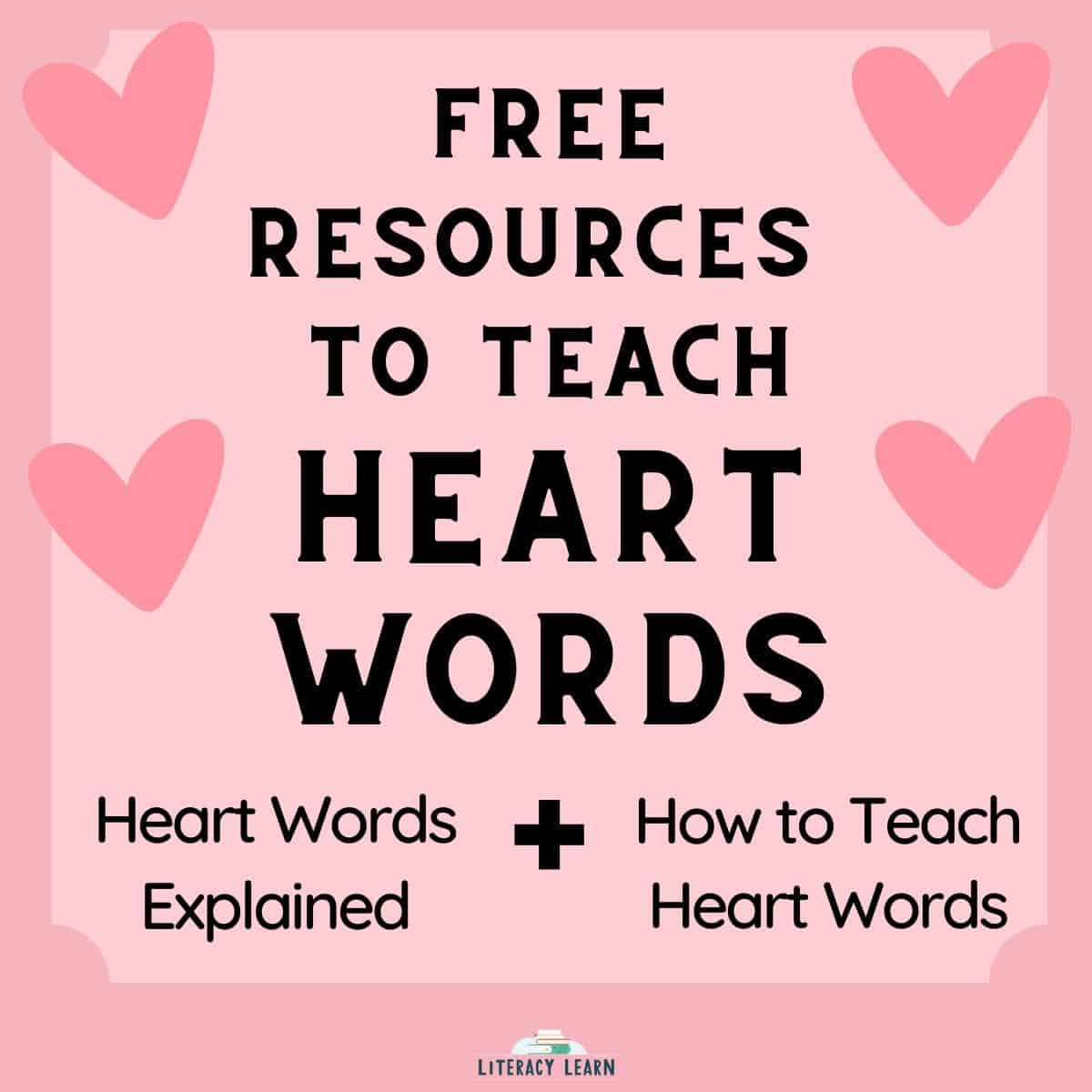
♥ What Are Heart Words?
Heart word is the term we use for an irregular word. An irregular word includes a part of the word where the word’s sound does not match the spelling or follow common spelling rules.
Different programs sometimes refer to these words as irregular words, puzzle words, trick words, or red words.
All of these terms essentially mean the same thing. Part of the word is not decodable, so it needs to be memorized ‘by heart.’
👉 It’s important to note that the majority of heart words include parts where the sound matches the letters. So heart words will usually include decodable portions, along with the ‘heart’ parts that must be memorized.
❤️ Heart Word examples include words: could, talk, do, of, look, said, you, says, was, and goes.

Sight Words vs. Heart Words vs. HFW
It’s also important that we understand the difference between terms that have been used interchangeably in the past.
There are specific and important differences between the definitions of high-frequency words, sight words, and irregular words.
High Frequency Words (HFW) are the most commonly words used in the English language. These are the Dolch or Fry Word Lists that we see most often in text.
Sight Words are words we recognize instantly without any effort to read. Every child’s sight word bank is going to be different based on what words they can read automatically, without effort.
An irregular word is a word that includes a part where the sound does not match the spelling. These are referred to as Heart Words.
The short answer is no, but sometimes yes, they can be the same! Many HFWs are totally decodable and should be taught as such. This includes words like red, three, and me. However, there is overlap between the two categories of words. Some HFW, like the word ‘do,’ include an irregular part. And some HFW, like the word ‘of,’ do not include any decodable parts.
Why We Teach Heart Words
We know from fMRIs (brain scans) and other studies that our brains don’t learn to read using the whole word method.
Instead, science tells us that our brains learn words by connecting phonemes and matching them to graphemes to build connections and store in long-term memory. We call this process orthographic mapping.
Dr. David Kilpatrick (2016) defines that orthographic mapping as, “the process we use to permanently store words into long term memory.”
Teaching heart words is a research-based practice that takes kids through this mapping process to turn unknown words into automatic sight words.
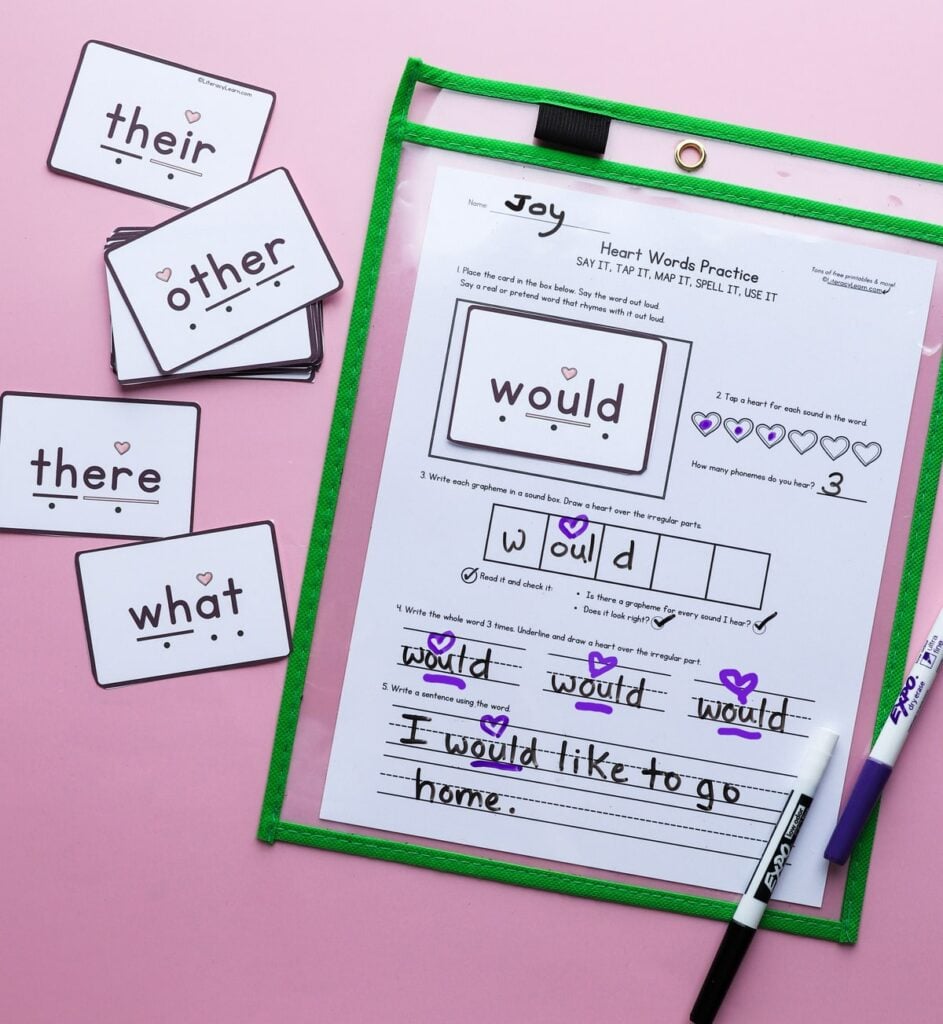
How to Teach Heart Words
We begin the teaching procedure at the sound level, introducing the word orally at first. Steps 1-3 below outline this sound-level procedure.
Then we move from speech to print, providing the graphemes (spellings) for each phoneme (sound). Steps 4-6 below outline this procedure.
Follow this research-based procedure for teaching heart words:
- The teacher says the word out loud, and the students segment the sounds they hear in the word by finger tapping and saying the sounds aloud.
- Use sound boxes and manipulates (like chips) to mark the phonemes for each word. Kids say the sounds they hear while simultaneously pushing up one chip for each sound in the word.
- Using sound boxes, instruct children to show them which part of the word is the ‘heart’ part of the word that must be memorized. Put a heart on top of the box.
- Spell the word matching the sound to symbol (orthographic mapping), and draw close attention to the heart part of the word. Then, rewrite the word together.
- Practice rewriting the word, saying the letter names aloud when writing.
- Provide repeated opportunities to practice reading and writing the word.
Once you have explicitly taught the word, allow kids to practice independently or at centers to get lots of exposure with the words.
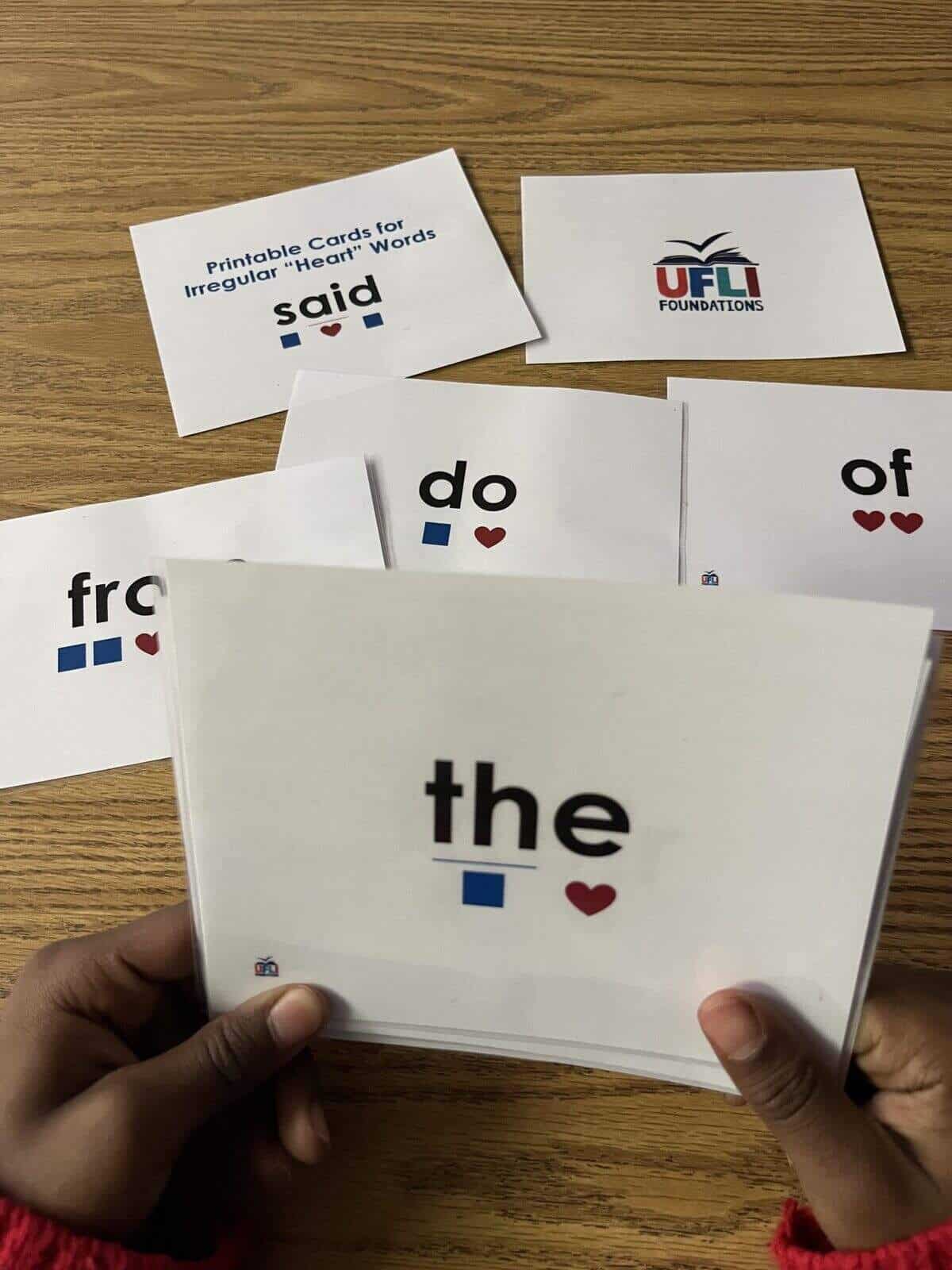
✏️ Free Teaching Resources
Here we’ve collected links to some AMAZING resources to help make teaching heart words easier!
And a HUGE THANK YOU to all the publishers and creators who have developed these free heart word resources to share with others. We are so grateful that you met this need to help our kids learn irregular words in a scientifically backed way!
Really Great Reading
Really Great Reading is an awesome resource for heart words, and they also provide free OG training webinars to learn more about the Science of Reading. They have developed amazing videos reviewing individual heart words.
We suggest introducing the words at the sound level first, following the procedure listed above. Then use these videos to reinforce the spelling of the irregular word and engage your students! Check back often for new videos and words.
University of Florida Literacy Institute (UFLI)
UFLI has created a Foundations Toolbox that includes lesson resources for heart words.
UFLI provides virtual options to present heart words, including presentations in google slides and PowerPoints.
The best part about this is that they included notes at the bottom of the google slides to explain the irregular parts of the words to you! I have used this resource numerous times when I have a question about an irregular word.
UFLI also produces printable heart word cards to send home with students, along with an explanation of what heart words are and what the symbols mean.
UFLI provides a sample heart word lesson with an actual student to demonstrate what teaching a heart word looks like in real life (virtually)! Be sure to take a look!
TPT Free Resources
📃 Parent Letter: Grab this free parent letter that explains what a heart word is!
It’s important the parents understand the terminology our kids will use, as well as the markings that they may see on some of their work.
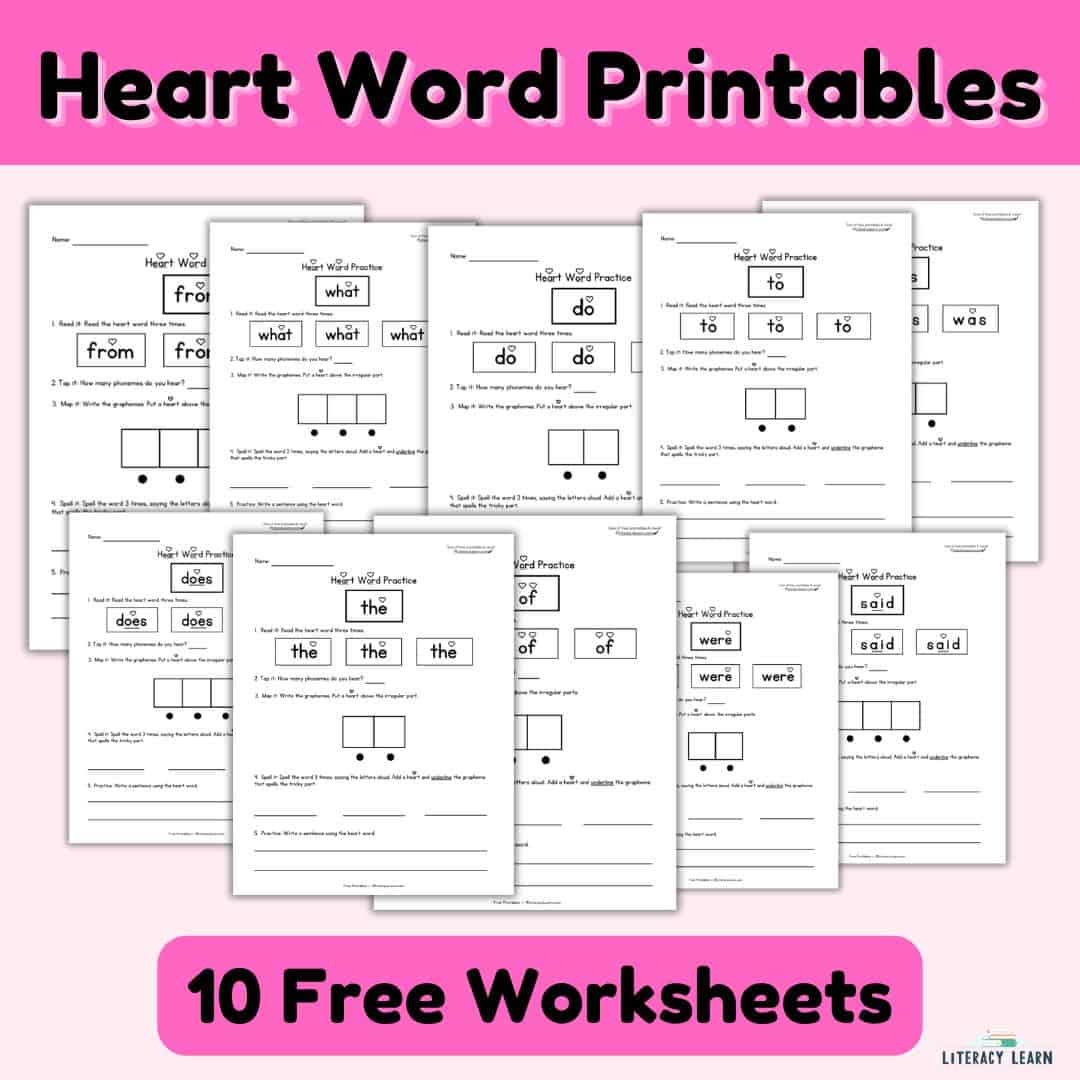
📘 Heart Word Printables: This resource gives you 10 free printables for some of the most commonly used heart words! Kids will practice reading and spelling heart words with explicit practice opportunities.
♥ Heart Word Challenge: This excellent resource created by Learning with our Littles is a free Heart Word Challenge.
I love it because it provides visual representations of phonemes within the heart graphics, reminding kids what the irregular part sounds like!
Related Posts
- 6 Syllable Types: All You Need to Know
- Science of Reading Morphology Poster
- Orton-Gillingham Training: The Best Options Out There
- Hundreds of FREE Decodable Readers
- Decodable Sentences for Every Phonics Skill
- Check out our favorite Dyslexia and Dysgraphia Learning Software (use code LM10 for 10% off)
We’d love to hear about your experience teaching heart words.
Please leave a comment below or tag us on Instagram @literacylearn.

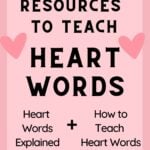
Where can I find the worksheet at the top of the post that is in the dry erase pouch?
Hi Mandi,
That is from our popular TPT product and can be found here.
Katie and Laura
Thanks for this insight – definitely going to use it during my tutoring sessions.
Venetta,
We are so glad you can use these free heart word resources with your students during tutoring!
Katie and Laura
Thank you for this. I just saw this in a video and was wondering more about it and you have offered a lot more info about it and thanks for the printable resources.
Ana,
We’re so happy to know that this helped clarify information about teaching hear words! We’re hoping it transforms the way people teach irregular words.
Katie and Laura
Thank you for sharing, I love this!
Hi Susan! It’s our pleasure! Be sure to sign up for our emails so you get a new freebie every week! 🙂 -Katie & Laura